Hi everyone, and welcome back to the Mirror Gallery. This week we are looking at another work by Ryan Pancoast that made its way into my collection a few months ago, and it is unlike any other: a color sketch for the Theros card Mistcutter Hydra.
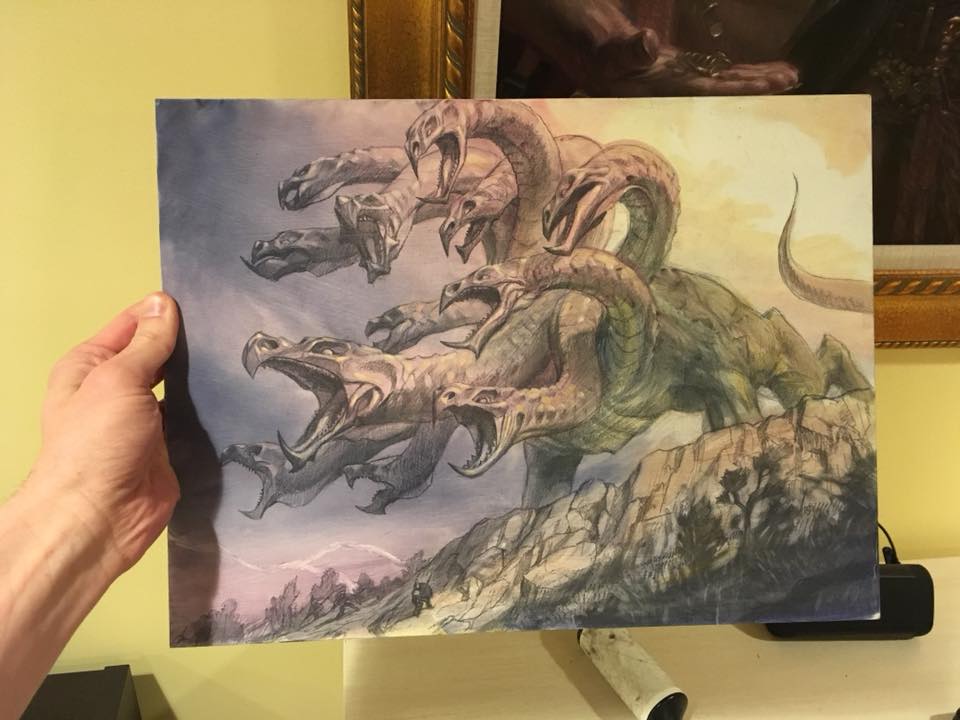
Before the Frame: Mistcutter Hydra by Ryan Pancoast, oil on board, 12” x 16”
You’ve seen two of Ryan’s color studies in a previous article, but this work is different than what we usually see from him. I had the opportunity to ask Ryan why:
DC: Last time I asked about a color study and where it fit into your process, but this is more of a color sketch. How does this fit in? Do you do many of these?
RP: This served as a color study/sketch but it wasn’t initially intended as such. This was an attempt at the final. It was my first attempt at painting on board, but I got nervous as this point about how the paint was behaving on the surface and decided to scrap it and start again on canvas. Ah, to have that kind of time. No longer. In any case, it served as good reference for the drawing and a good color study as I moved forward.
Abandoned traditional finals are something I don’t ever recall seeing on the market for original Magic art. Deadlines are a real thing, and starting over only happens in emergencies or extreme circumstances, like above when the paint begins to misbehave. I had no idea that this was an attempt at the final until writing this article, but it now occupies an exciting place in my collection I didn’t even know existed.
Throughout this article we are going to hear more from Ryan, both about this piece and his personal project that I absolutely love. We will also trace a history of hydras through mythos and Magic, and as we usually do follow this piece from acquisition to its framed home on my wall.
The Artist

Ryan Pancoast, his son, and the finished Saheeli painting
Ryan Pancoast has illustrated 88 cards for Magic as of this article, and three more since the last time we looked at a piece of his in my collection. His most recent painting was his first Planeswalker commission, Saheeli, the Gifted for the Commander 2018 set.
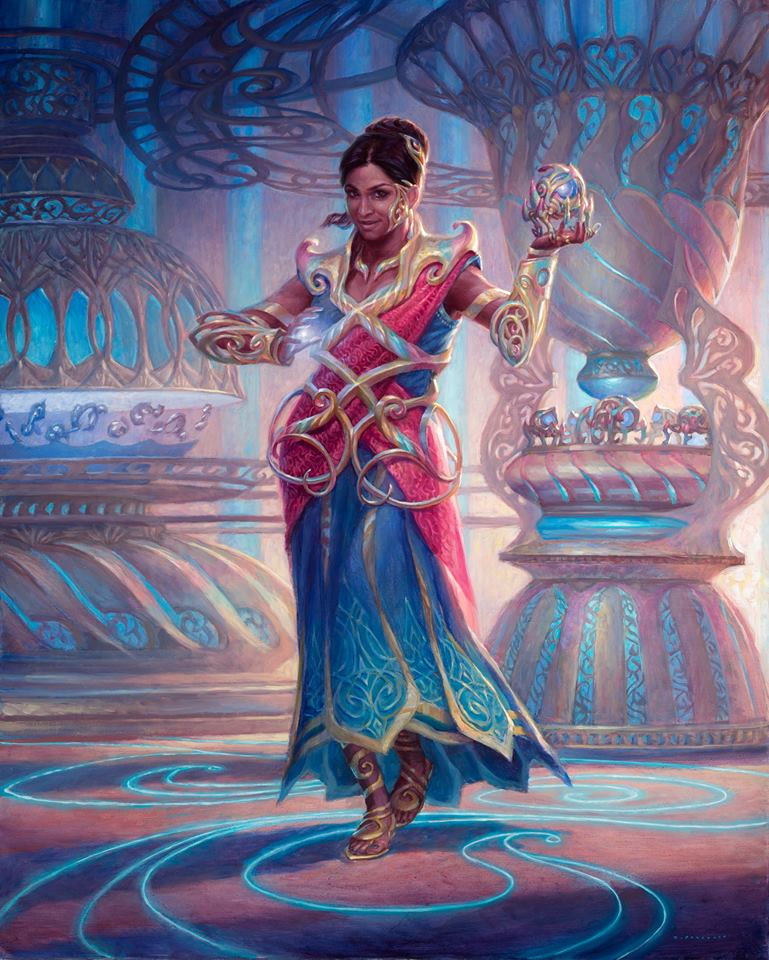
Measuring 24” x 30,” it is a HUGE oil on canvas and an incredible work of art. It is also one that guarantees him a place in the planeswalker consideration conversation moving forward. It recently sold for $7700 on the MTG Art Market, and I’ll talk more about it in an upcoming article.
Last time we looked at Ryan’s work I covered the volume of art he has been recognized for in Spectrum, the art annual that includes the best in fantasy and imaginative realism, as well as his Chesley award nomination, which is the top honor in the genre. Today I want to introduce you to his personal project called Frontier Fantasy:
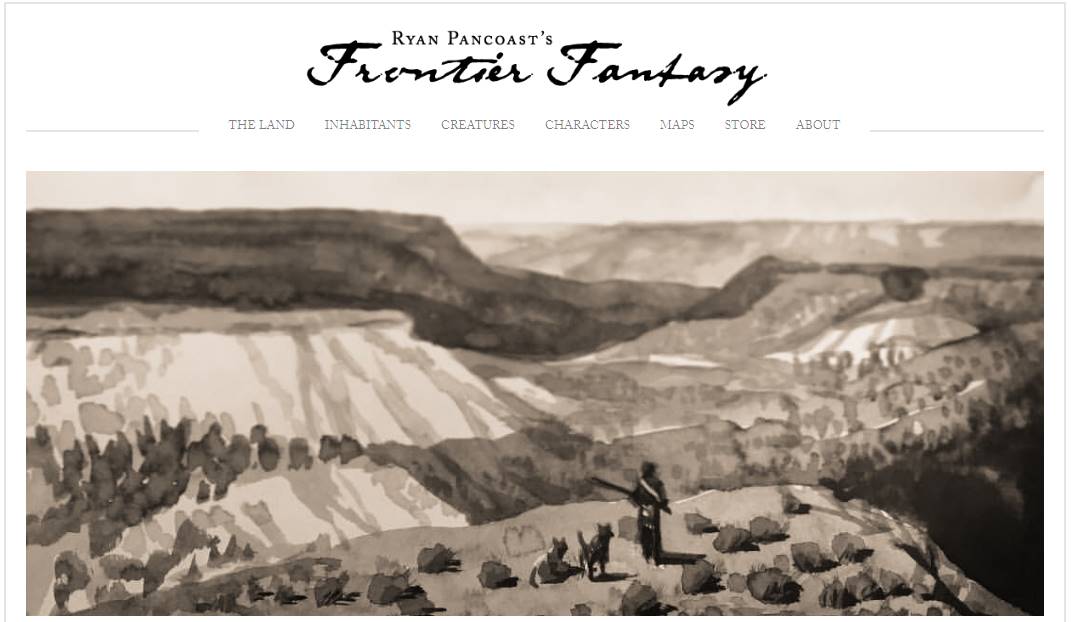
DC: Can you describe what Frontier Fantasy is, and where your inspiration came from?
RP: Frontier Fantasy is the world of my personal work. It is a fantasy version of the American frontier at roughly the early part of the 19th century, although my work never intersects with real-world history. The world was created out of my love for American history and fantasy art, and my belief that “fantasy” doesn’t always have to follow the Tolkien format or aesthetic.
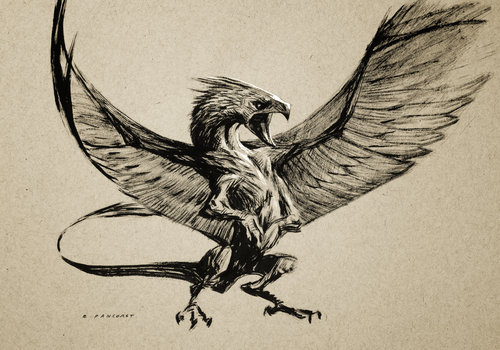
A Copperhawk of the Great Mountains. Ink on paper. Image from the Frontier Fantasy website.
Ryan goes even more in depth about his motivation for Frontier Fantasy here. You can delve into the entire world he has created, from the land to its inhabitants to full maps on the Frontier Fantasy website.
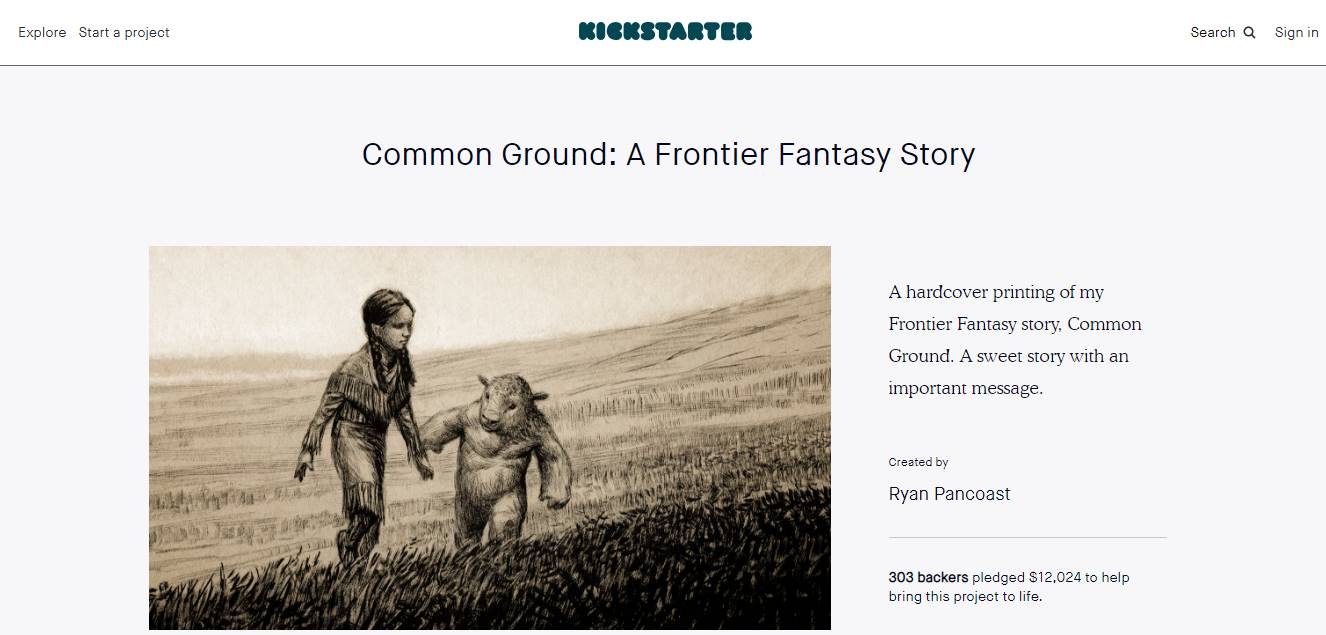
The first book exploring his characters and creatures, called Common Ground, was successfully backed on Kickstarter in March of 2017 and resulted in a 34-page wordless book with 30 inked illustrations that tell the story of Summer Meadow. I plan to pick up a signed copy at Illuxcon in a few months, and you can purchase your own copy here. Perhaps in the future I’ll write an entire article on this incredible world; it’s like nothing we have ever seen before and a truly unique creation.
But that’s enough of Copperhawks and Hoof-men for now; let’s reel it back in to our subject at hand: the Hydra.
Creature Feature: Hydra
Hydras in Mythos
For anyone that grew up in a Disney household, your first exposure to a hydra was probably this guy:
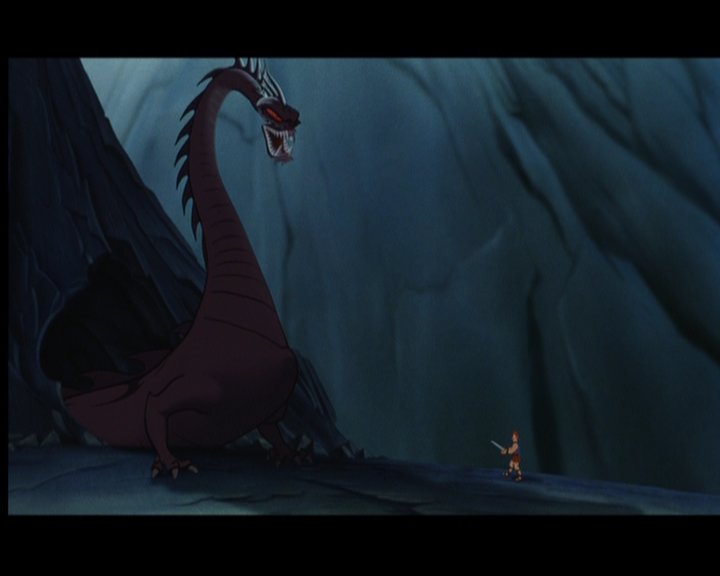
In the 1997 movie, the Hydra was the first attempt Hades sent to defeat the mighty hero Hercules. Slicing off the single hydra head from the inside out, he quickly found that for every head he cut off, three more would grow back.
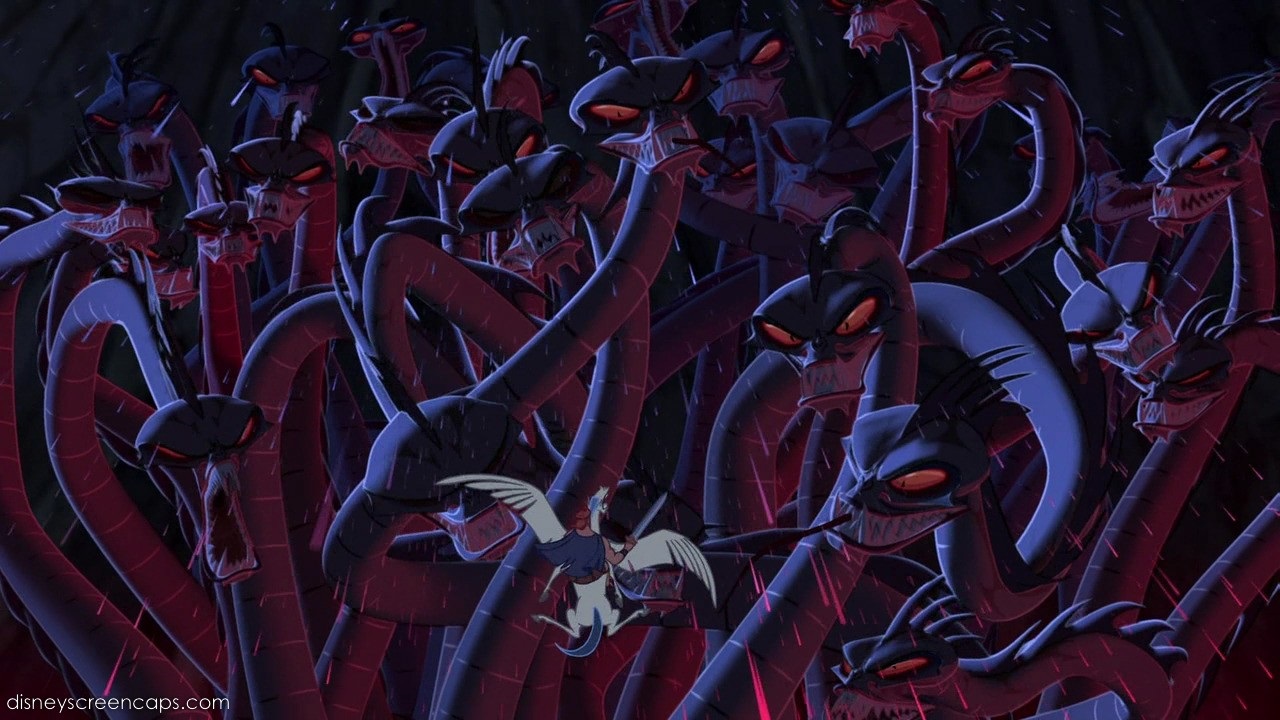
Only after burying the Hydra under an avalanche is he able to defeat it. If you’d like a little trip down memory lane, you can watch the entire scene below.
This part of the Disney story is loosely based on the story of the Twelve Labors of Heracles (Romanized to Hercules), of which the Lernaean Hydra was the second trial. In the myth, the Lernaean Hydra was a water-dwelling, nine-headed beast, and has been depicted as such both classically . . .
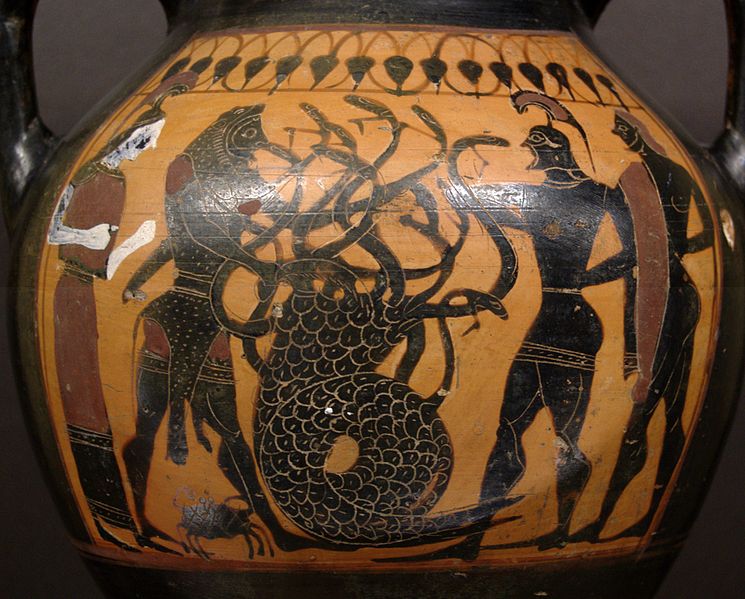
Manner of the Princeton Painter, Heracles and Iolaus fighting the Lernaean Hydra, 540-530 BC, black figure ceramic, 11.8” x 7.8,” Attica, collection of Musée du Louvre, Paris, France.
. . . and throughout history. The two works below were created 500 years apart, and 2000/2500 years, respectively, after the ceramic above.
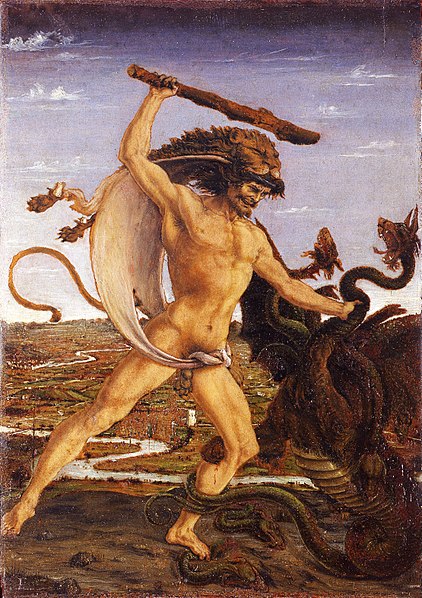
Antonio del Pollaiuolo, Hercules and the Hydra, tempera on panel, 6.6” x 4/7” (c. 1475). Uffizi Gallery, Florence, Italy. Image courtesy of the Google Art Project.
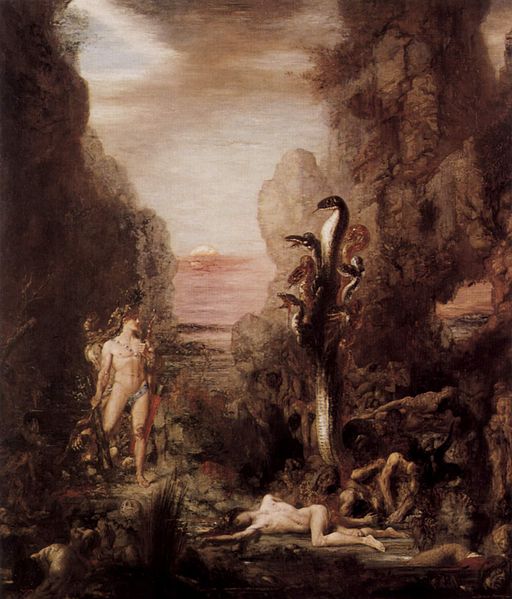
Gustave Moreau, Hercule et l’Hydre de Lerne, oil on canvas, 70.5” x 60.6” (c. 1876) Currently at the Art Institute of Chicago.
The details of Heracles’ victory has changed over time, from killing the hydra’s central head with the Golden Sword of Athena to having his nephew Iolaus cauterize each head as he cut it off with the hydra’s own venom to prevent regrowth. The regenerative nature of the Hydra’s heads has also changed over time, with varying accounts about the nature and quantity of heads that may or may not regrow. To trace this evolution, or if you’re just curious to learn more about the Hydra’s description and depiction in folklore, check out Chapter 1 of Daniel Ogden’s 2013 work Drakon: Dragon Myth and Serpent Cult in the Greek and Roman Worlds.
In short, the hydra is remembered canonically through history as being a great beast with heads that regenerate, and this theme of multiple heads that can increase or decrease in number is what chiefly identifies them within the Magic multiverse. Let’s see how.
Hydras in Magic
Hydras have been around since the beginning of Magic, with the first printing of Rock Hydra in Magic’s Alpha. Through Commander 2018 there have been 41 different hydras printed in Magic, and no two of them are the exactly the same in depiction or function. The earliest hydras were Red, and illustrated as we see them depicted in Disney’s Hercules and other pop culture: multi-headed, very angry, dragon-like beasts. Through the Nemesis expansion (2000), hydras remained firmly in the color.

Magic didn’t see another hydra for five more years, when “phyto” or plant-headed hydras entered the scene. This Selesnyian take on the hydra opened the door for all sorts of hydra interpretations, most having a similar body to the traditional hydra but flavor-specific heads to match their setting, situation, or style.
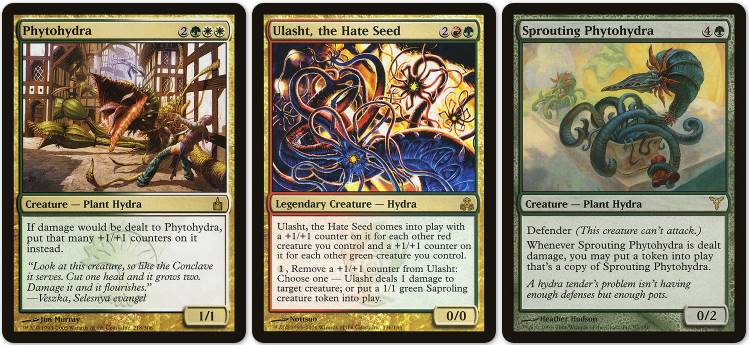
Since then we have seen hydra in all shapes and sizes. Those with a strong plane identity…
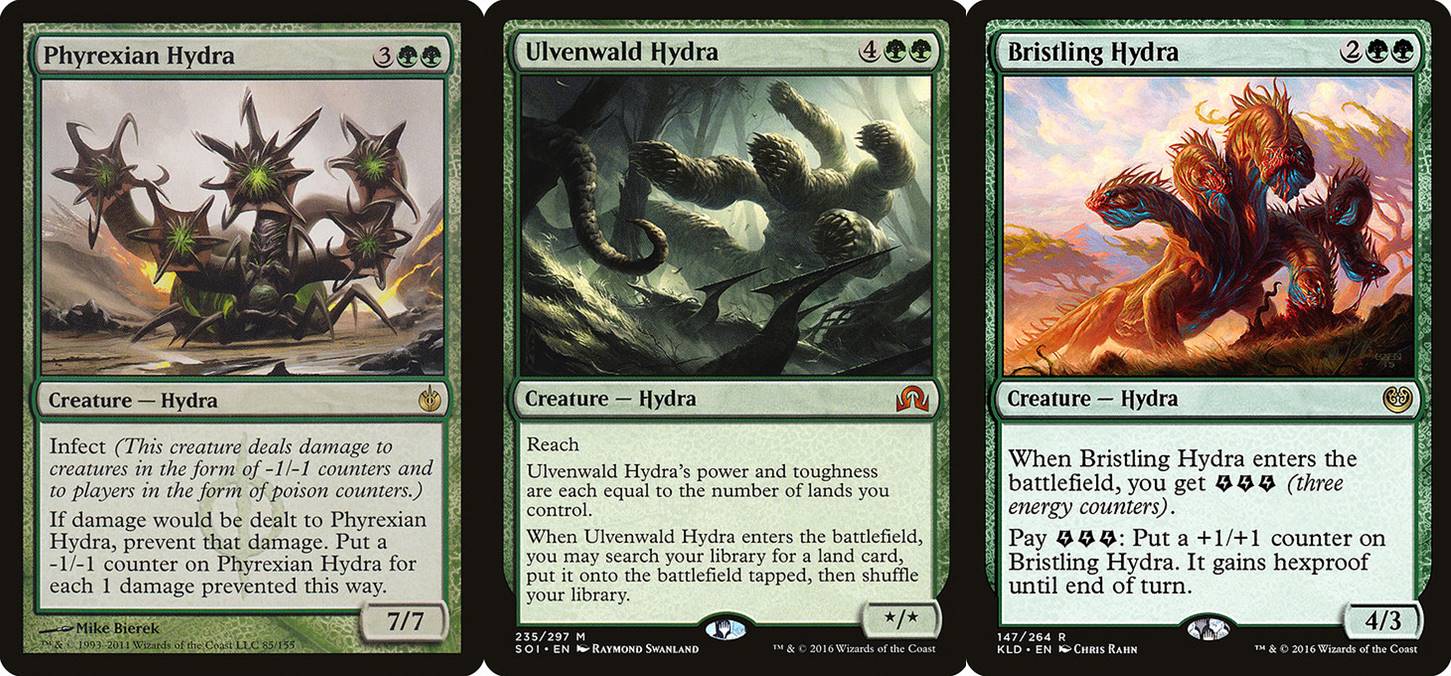
Others that have been a bit unconventional…
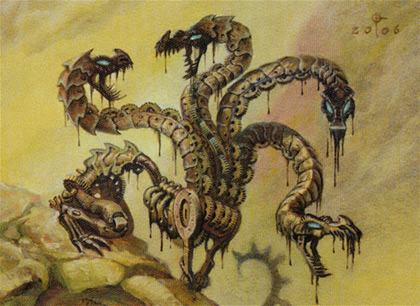
Clockwork Hydra by Daren Bader, Time Spiral, Traditional
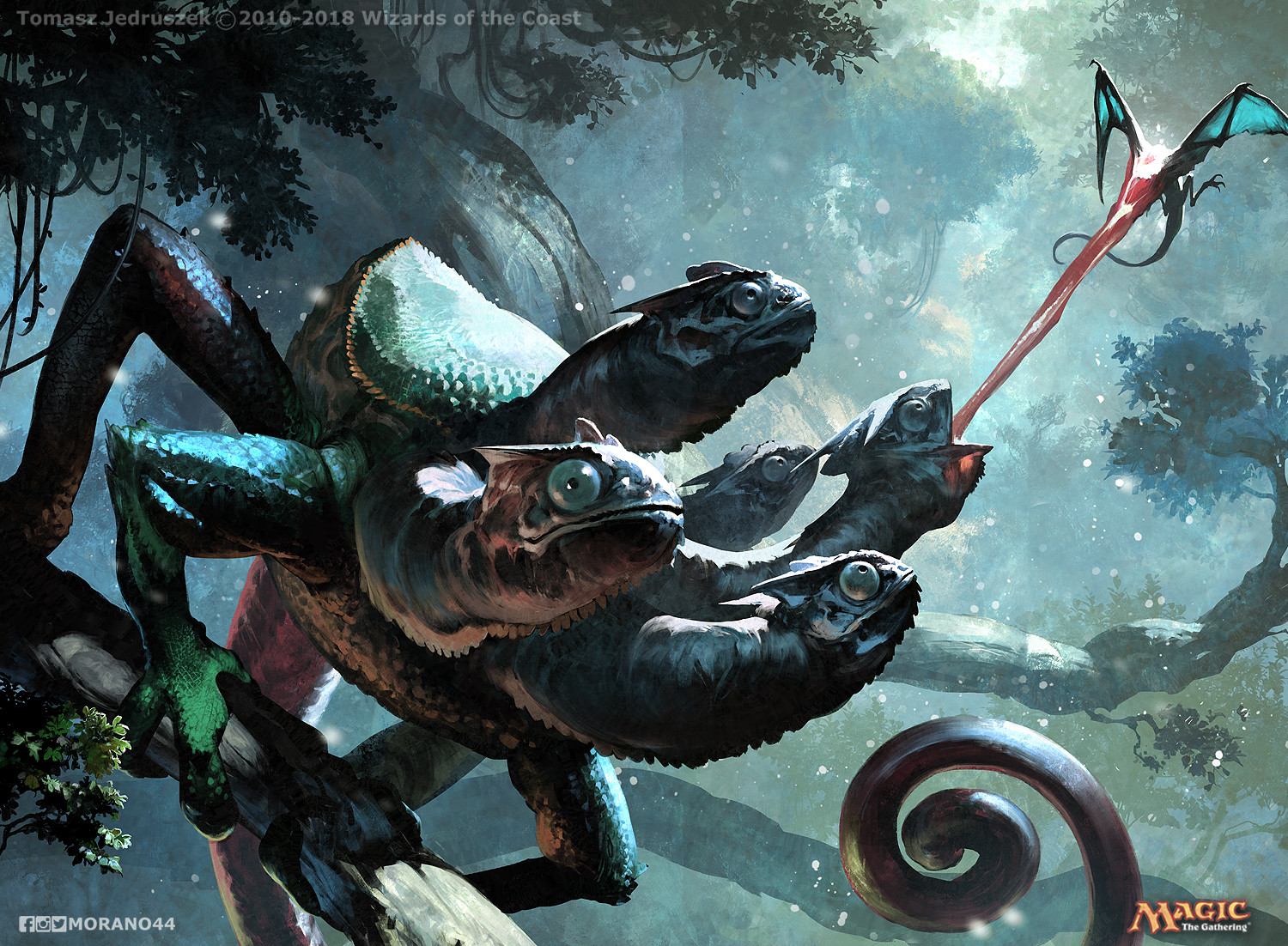
Whiptongue Hydra by Tomasz Jedruszek, Commander 2018, Digital.
And a few that are nothing short of Legendary…
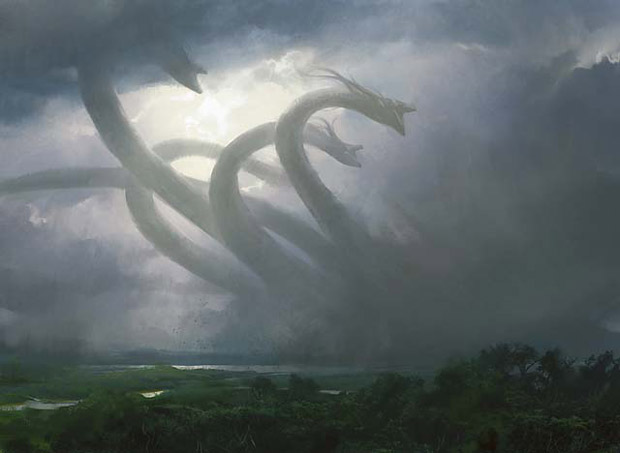
Progenitus by Jaime Jones, Conflux, Digital.
(You can check out the original Progenitus sketches here.)
I would love to be able to put together a compilation of all the hydra artworks next to each other, just to show the diversity of depiction over the last 25 years. To see every printing of every hydra, follow through to Scryfall and behold the visual variance. They are one of the most unique creatures found in Magic, and have been adapted to almost every plane in their own exclusively unique ways. Let’s focus in a little closer and see what a Theros-ian Hydra, like Mistcutter Hydra, really looks like.
Where Are We?
Theros
It would seem fitting that the hydra, a creature right out of Greek mythology as we have seen, would find its prevalence in the top-down Greek inspired Theros block. In this block, inclusive of the Heroes vs. Monsters Duel Deck, we saw six different hydra creatures and nine different illustrations, equaling about 15% of the total hydra creature base in Magic (and that’s to this day, not just current to then). We also got a Hydra Token, flavorful Instant, and the fifteen-card “Face the Hydra” deck.
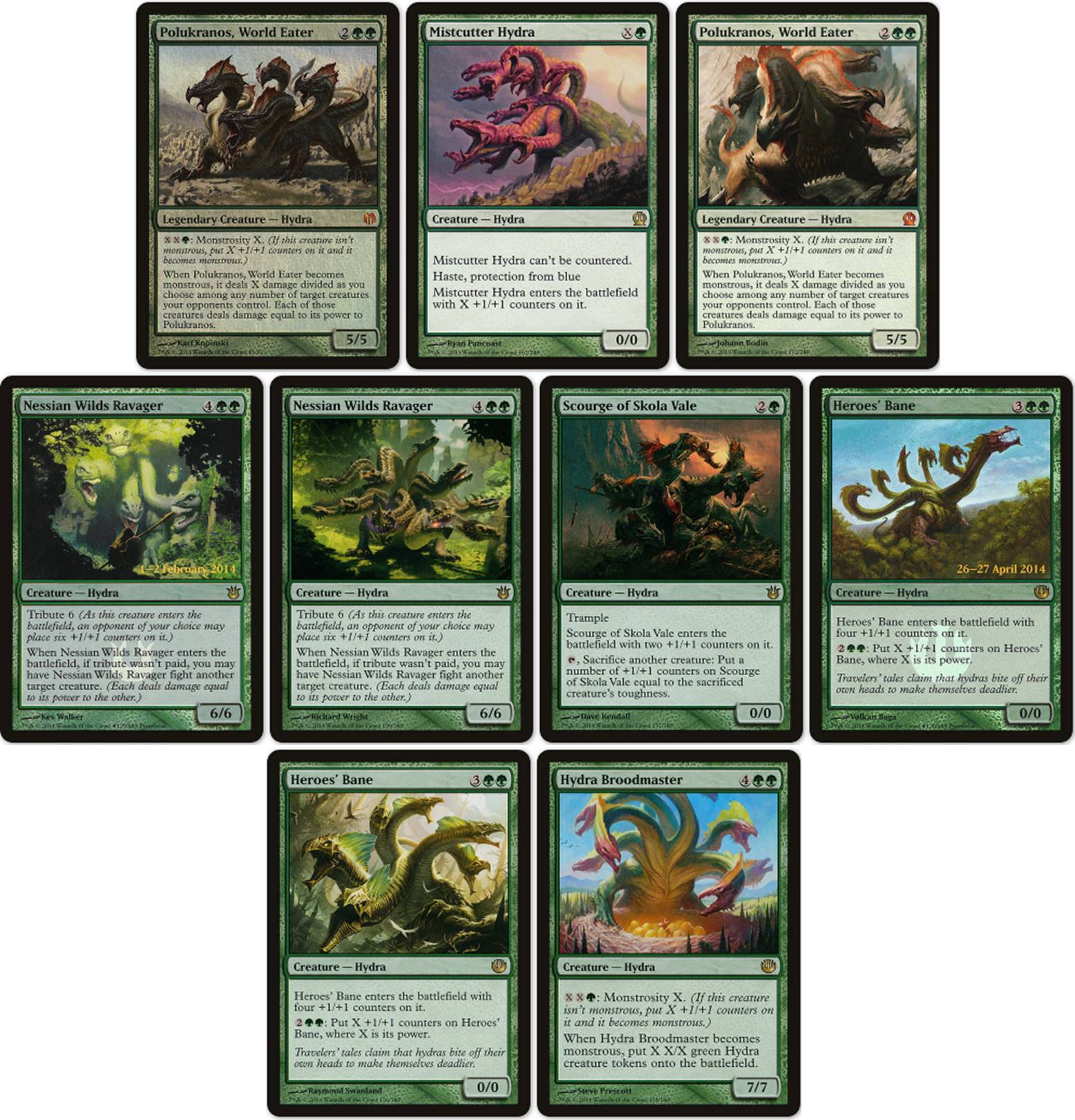
Theros hydras are stylistically similar, and this is not a mistake. Back in my article about Matt Stewart’s Gilded Cerodon I made mention of the Magic style guide, given to all artists at commission time to create cohesiveness amongst illustrations. It’s what makes a world look like a single, unified plane. Let’s hear from Ryan for a bit more insight into how this piece came to be:
DC: Was there anything exciting or particularly challenging about this piece (I know it was a while ago)? A hydra on Theros seems like a fun commission.
RP: Hydras are fun, and I liked the piece when I completed it and still think it’s a success, but monsters aren’t my forte. So it was a little bit of a slog. The trick was to get that many heads visible and distinct, because for some reason based on the prompt, I thought the specific number of heads was important.
DC: What sort of reference did you use for the hydra? Historical? Fantasy? Sci-Fi? Other Magic?
RP: My main reference was the style guide since Theros hydras have such a particular design. I decided to scrap the head fins that most Theros hydras have (again, to make all the heads visible) figuring not ALL Theros hydras looked the same.
Outside of the head fins, we see all the other continuities of Theros-born hydras; four large legs, a hulking dragon or lizard-like body, and long trail similar to a komodo dragon. Each hydra has very angular jaws and a snapping-turtle-like pseudo-beak for a mouth.
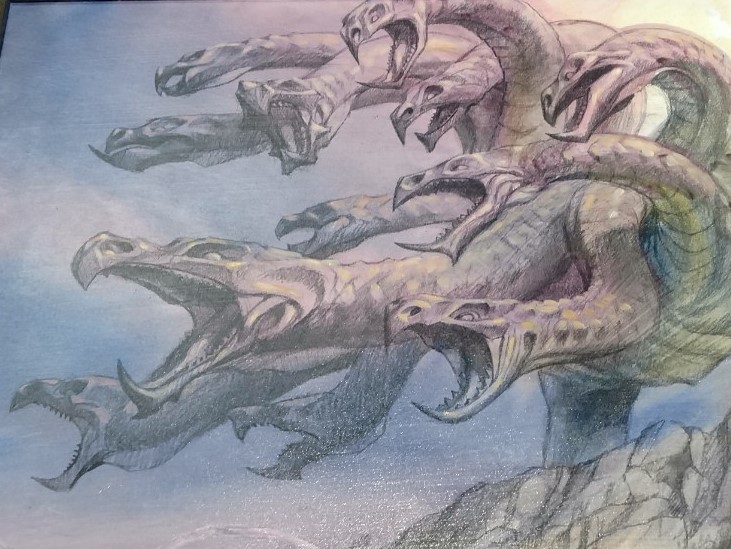
The hydras on Theros are all depicted extremely large, from towering over trees and breaking the cloud line to be shown alongside a “scale human.” In this piece you can see some very tiny scale people on the hillside.
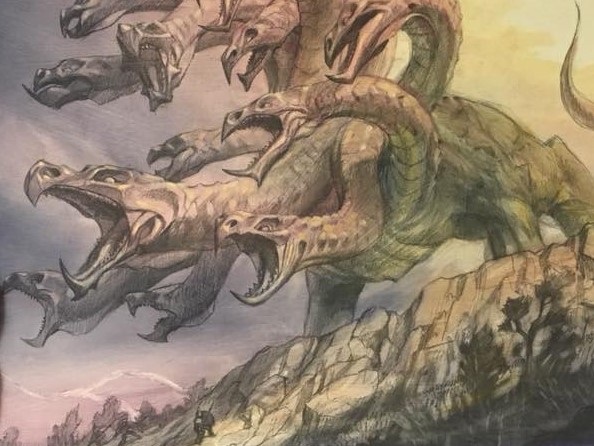
If we ever get a The Art of Magic the Gathering: Theros book, I’ll be excited to hear James Wyatt go into even more about the Theros specific species of these creatures. Perhaps we will even get some concept art to see exactly how the Theros hydra began!
Why This Piece?
The Work
The fact that this piece is an abandoned final is something we just don’t see very often. It has all the detail of a pencil sketch, but the application of color makes it truly unique. It reads as complete, yet occupies its own place in the artist’s process, the story of this work, and my collection.
The Environment
Theros was Magic’s first Greek-inspired set, and one that players had been awaiting for quite some time. It was the first block I played during my return to Magic, and I have fond memories of playing at the kitchen table of my buddy’s new apartment as we relived our childhood hobby. I don’t think we’ve seen the last of this plane; and I enjoy, as you all know, owning a piece that’s so representative of an environment and has a strong memory attached to it.
Put it on the Wall!
The color sketch for Mistcutter Hydra was the largest piece I had taken to my local framer, Ain’t That a Frame. I knew the frame was going to have to be larger, but I also knew that because this piece was done in oils and varnished, my budget would allow some flexibility as it didn’t require museum glass or acrylic for protection. What I didn’t expect was to once again find the perfect frame on the “ready-made” rack we have seen before in my articles.
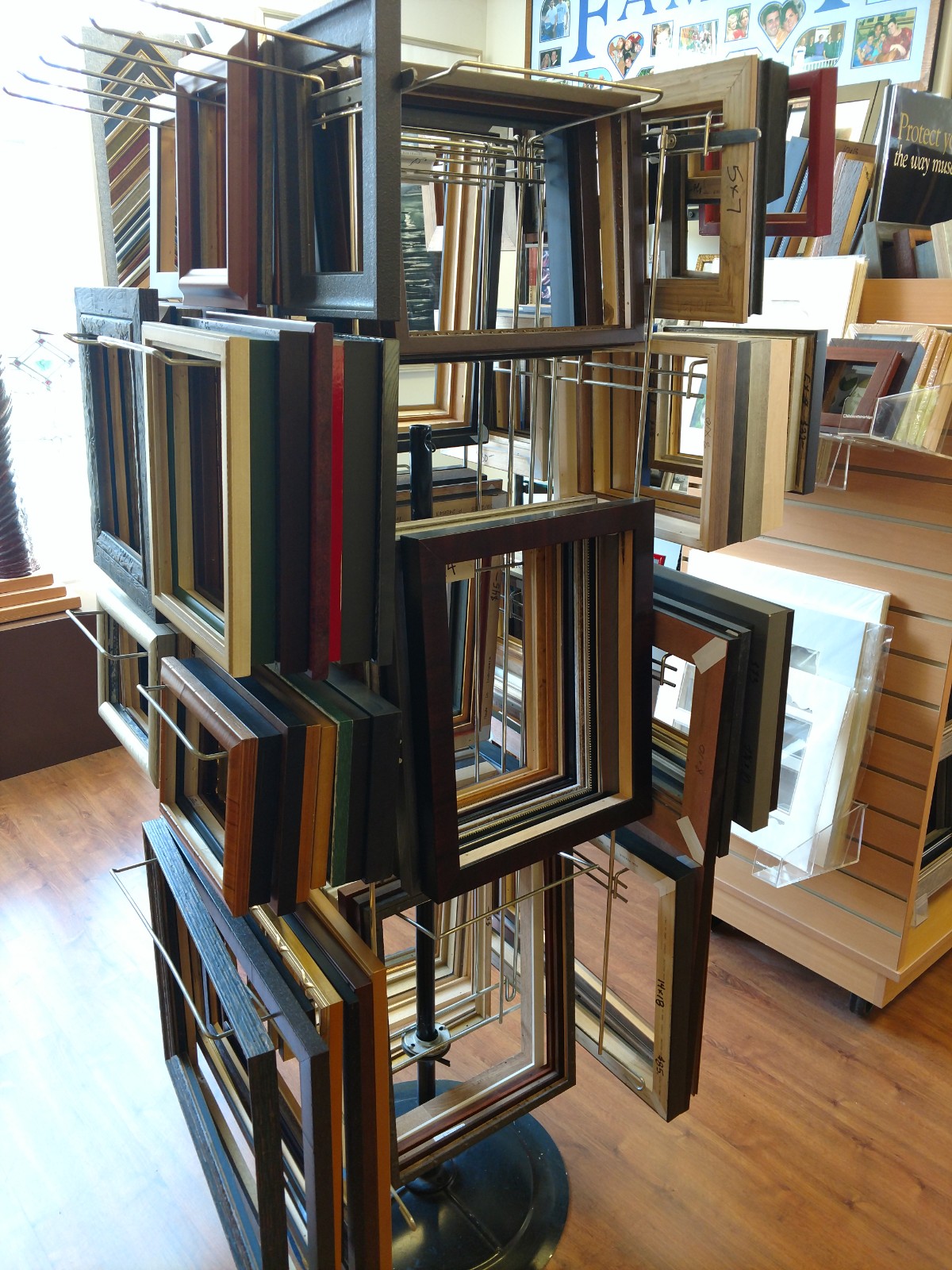
I usually take a few pieces each trip, knowing I’ll only frame half of them, but I like options. So while I was working with my framer Lou on the first piece, another Pancoast you all will see in a few months, my girlfriend was browsing those ready-made frame racks. She grabbed a frame she liked of the right size and brought it over as an option.
After a few tries from behind the custom counter…
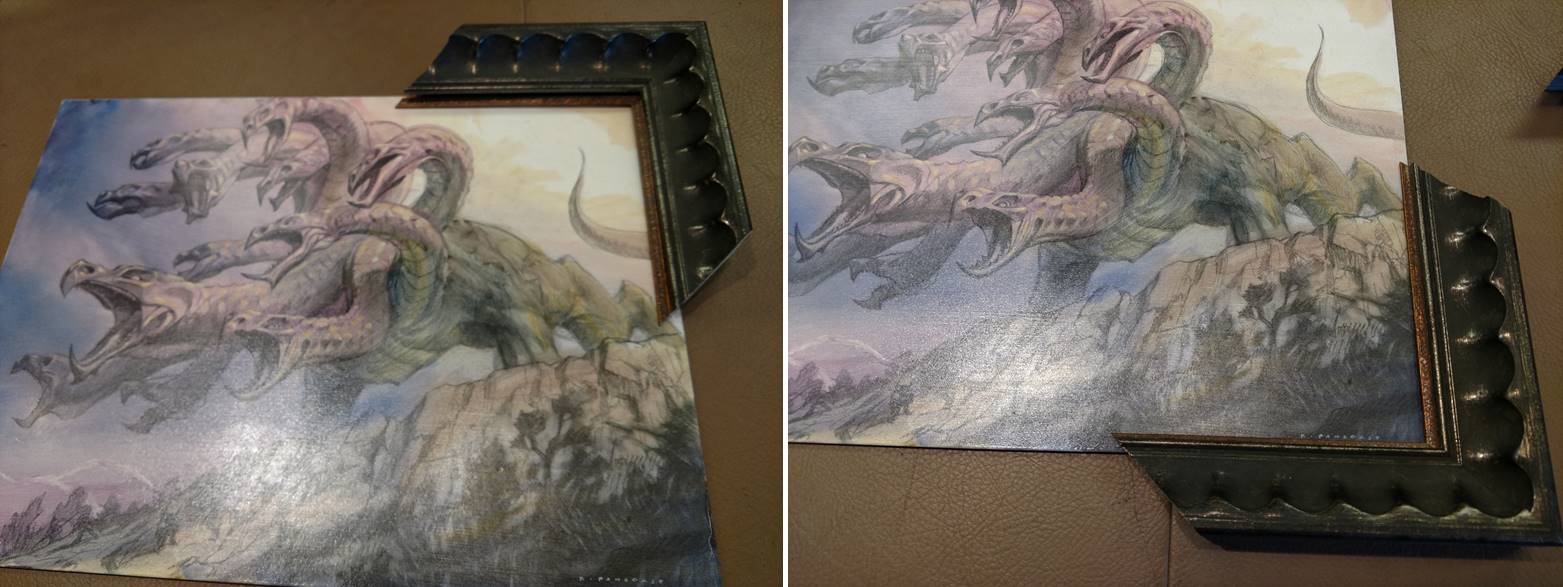
It didn’t matter the corner, it just wasn’t quite right.
We tried the one from the readymade shelf. And it was a perfect fit, and even better match.
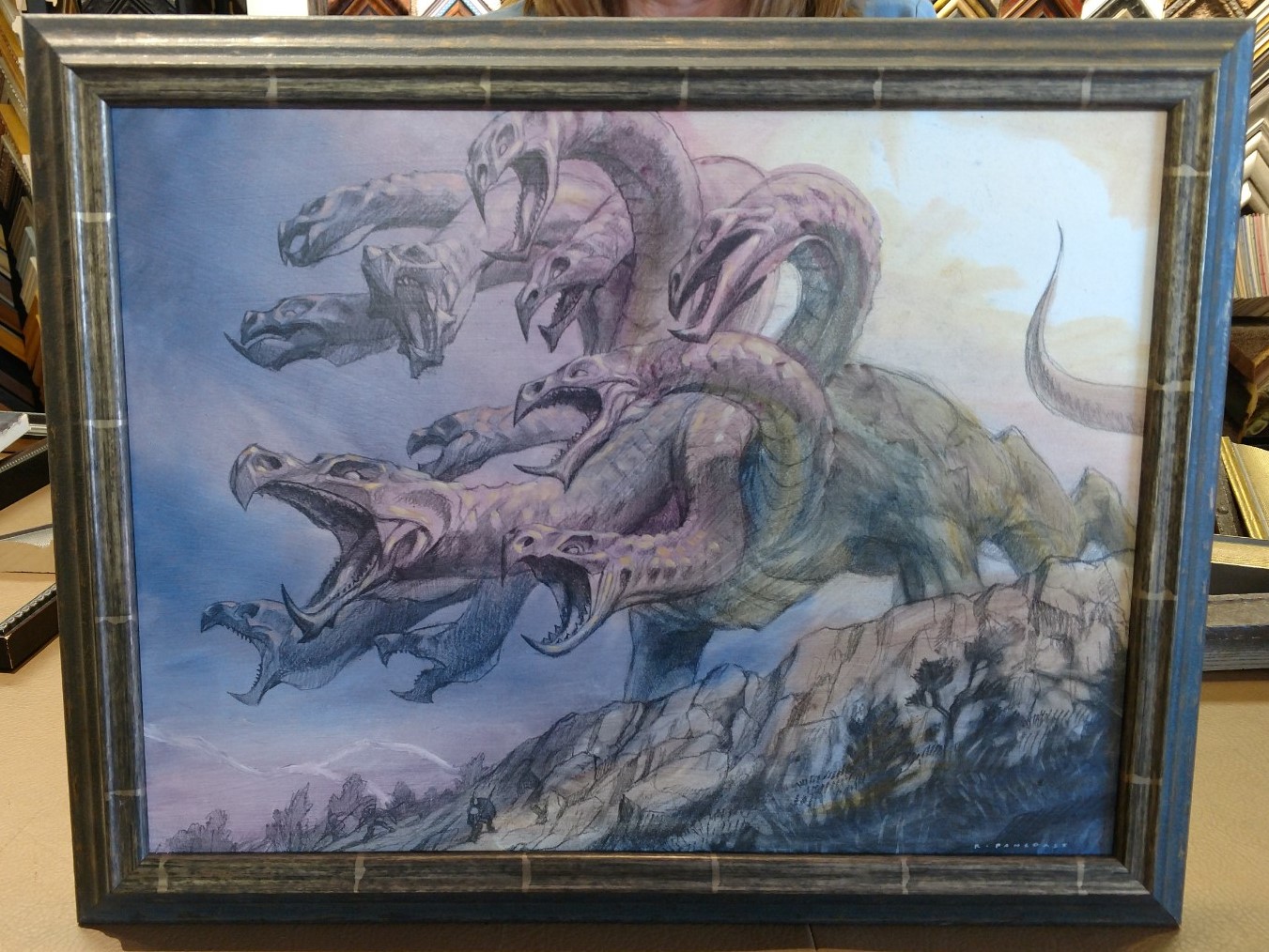
The combination really works, making the hydra look as if it had hung in the hall of a Theros Temple for a hundred years. I found out once I picked the finished work that this moulding by Larson-Juhl is called Etrusca. Etruscan civilization existed in Northern Italy (modern day Tuscany and surrounding) from around 800 BC until it was absorbed into the Roman Empire in 264 BC. Though entirely their own civilization, their proximity to Ancient Greece resulted in considerable influence. So as they shared cultures 2500 years ago, this Etruscan frame will house a Grecian hydra for the foreseeable future.
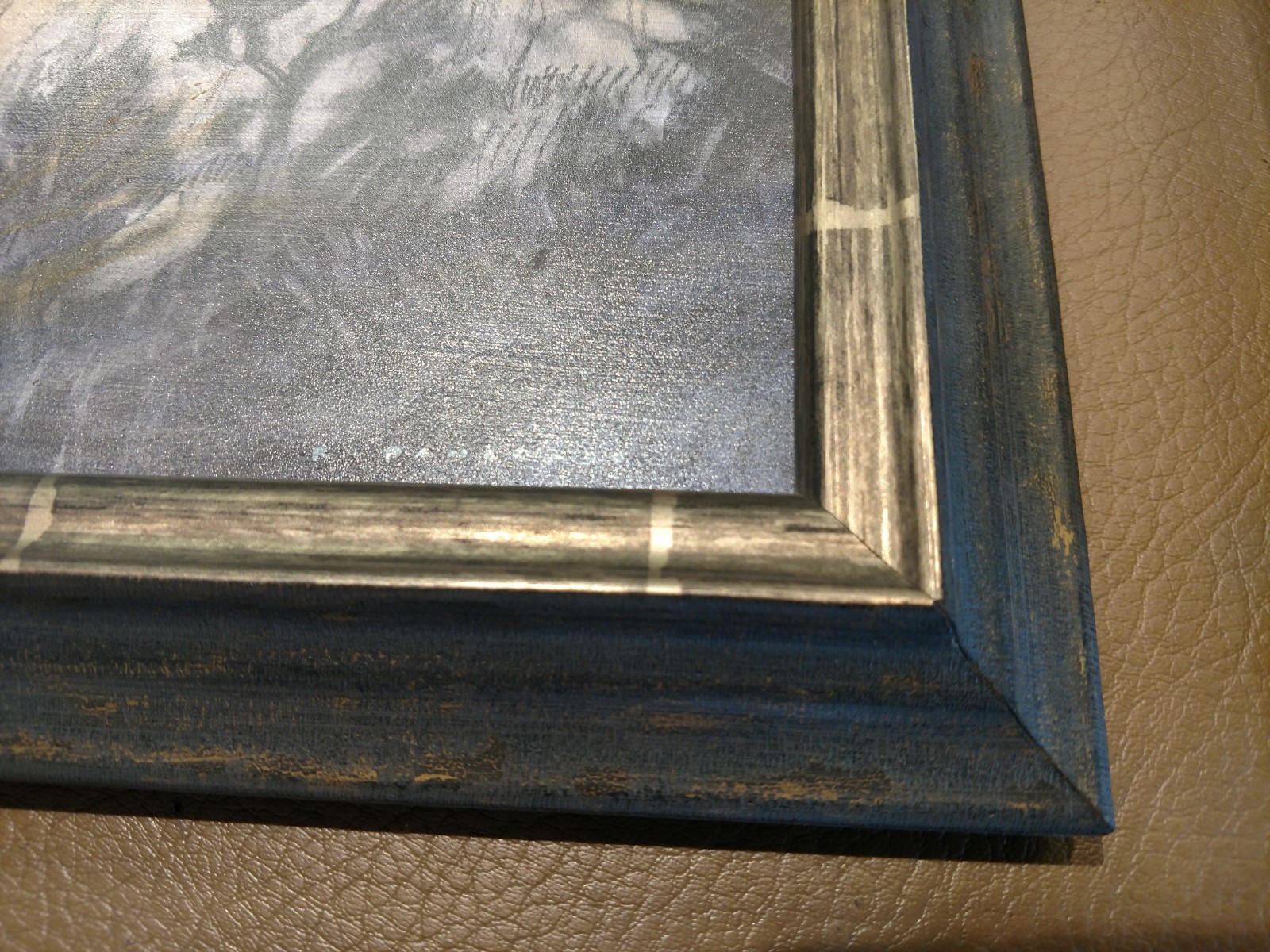
Build Your Collection
Ryan has sold a considerable amount of his original artwork since my last article covering one of his pieces, and most of his new releases for Magic head to eBay or the MTG Art Market shortly after they are previewed. He does still have a few Magic pieces available, as well as a pair of inks from his Frontier Fantasy project we explored earlier. You can find more information on these available works both here and here.
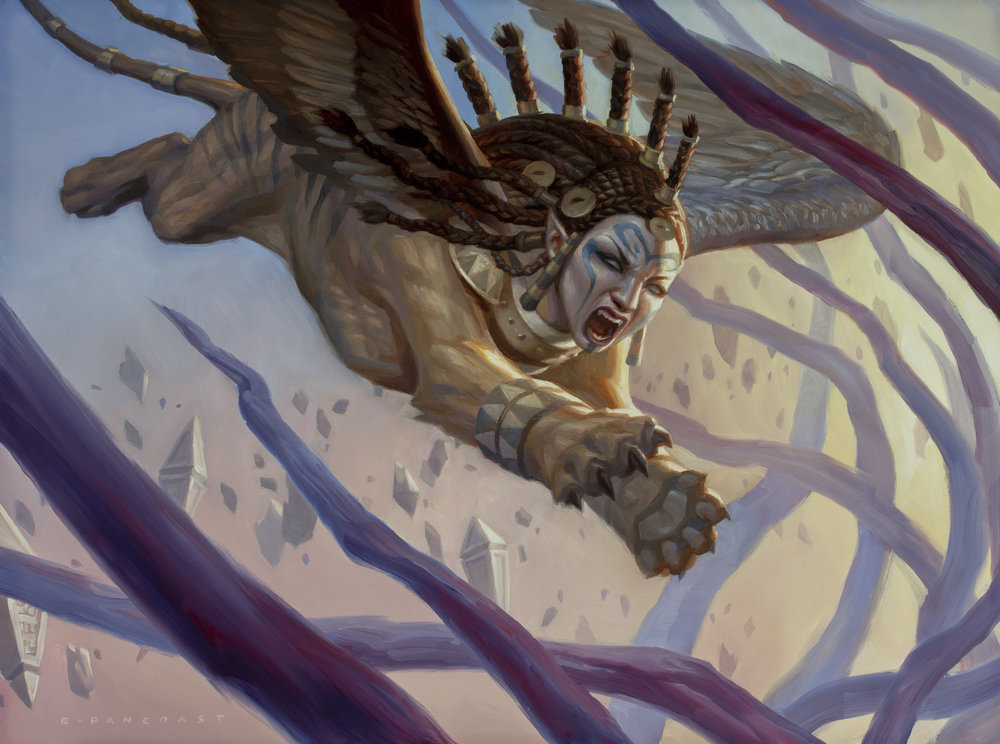
Jwar Isle Avenger, oil on board, 12” x 16” $1500
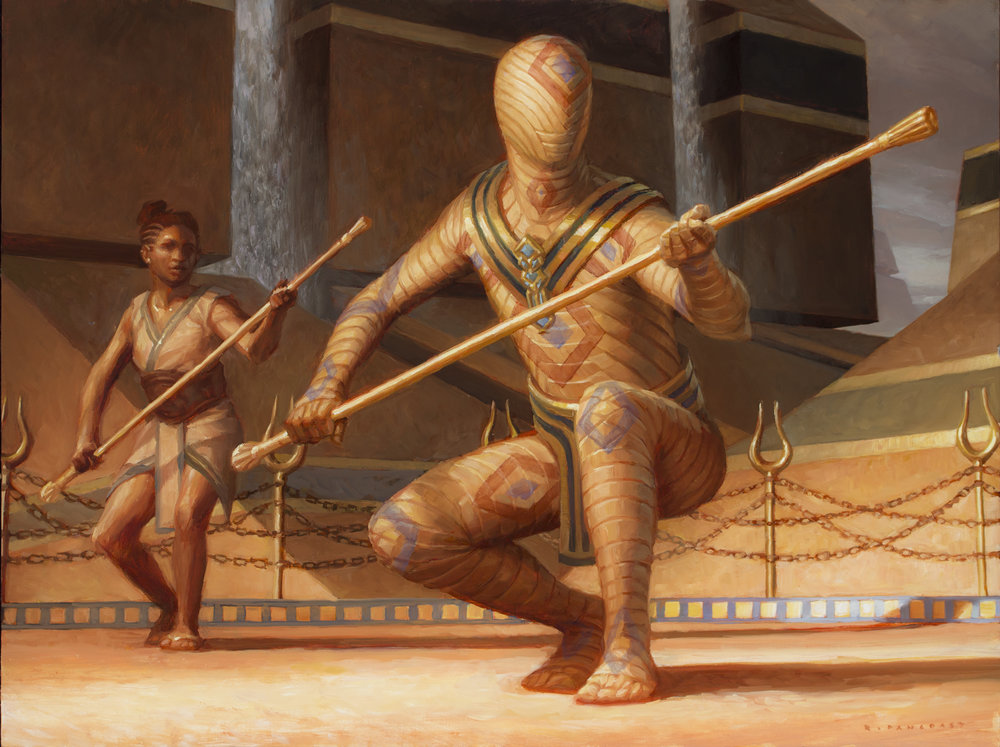
Sparring Mummy, oil on board, 12” x 16” $1200
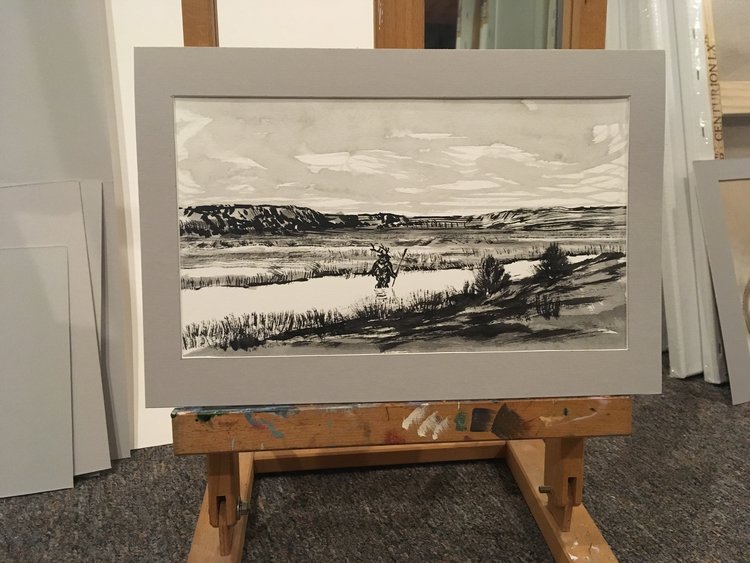
Hoof Man on the High Plains, ink on watercolor paper, 6″ x 10.25″ matted to 8″x12,” $150
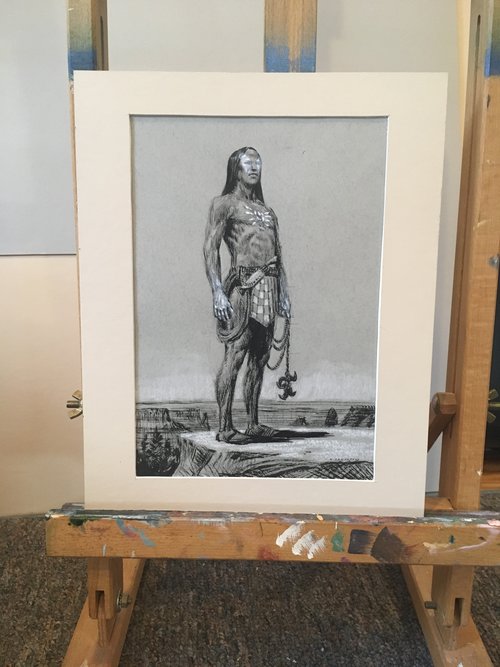
Frontier Fantasy Spider Man, ink with gouache and chalk, 5.5″ x 8″ matted to 8″x10.” $250
As I mentioned before, you can also purchase the first story in the world of Frontier Fantasy, Common Ground, directly from Ryan. They are $26 for a signed copy.
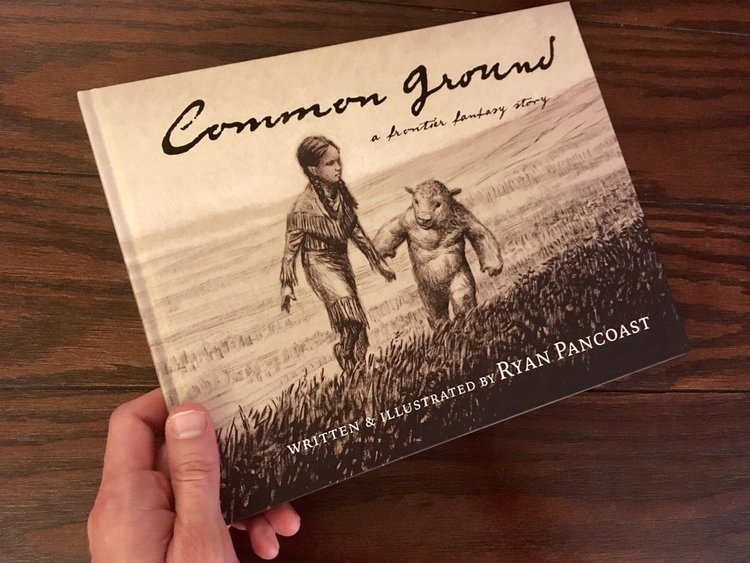
Wrapping Up
I hope you enjoyed this deep dive into yet another corner of Magic art, as well as the exploration of the hydra through history, mythology, and Magic. I also owe a heartfelt thank you to the artist. I’ve said it before, but Ryan Pancoast is continually creating some of the best art we see in the game; this work is but one example of his skill and dedication, and I’m privileged to be able to put his art on my wall and in my collection.
Next time we are going to be doing something a little different as we roundup the original art from Commander 2018 that sold over the past few weeks. We will take a look at the works that sold and where they ended up, as well as some digital art standouts that should be very popular in terms of prints, playmats, and artist proofs.
Remember, to see original #mtgart and other #vorthos related things, follow me on Twitter. Feel free to ask questions or retweet to continue the conversation. Thanks and see you next time!
Donny Caltrider has been playing Magic since 2002 and collecting original Magic art since 2017. He has an M.A. in Museum Studies from Johns Hopkins University and enjoys telling stories about art, objects, and the intersection of fantasy with real-life. You can find him on Twitter talking about #mtgart, museums, and other #vorthos related goodness. Follow along and continue the conversation!

